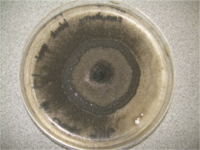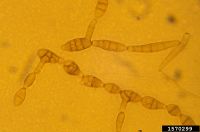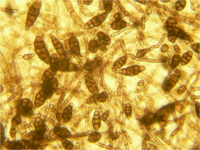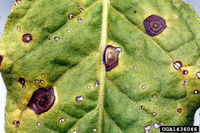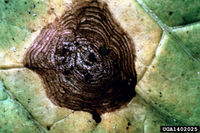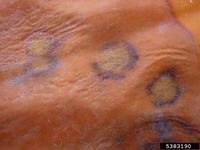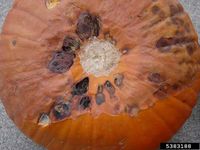Alternaria alternata
| Literature database |
|---|
| 679 articles sorted by: |
| • year (descending) |
| • research topics |
| • countries/regions |
| • host plants |
| • list of antagonists |

Authors: J.H.C. Woudenberg, J.Z. Groenewald, M. Binder and P.W. Crous
Source: Studies in Mycology, 2013, 75, p. 186
The fungus has a world-wide distribution and causes leaf spot, rots and blight diseases on various crops, as well as on stored fruits. The fungus favours warmer temperatures. Among the commonly affected crops are tomato, potato, cotton, strawberry and wheat. The fungus can form the toxins alternariol, alternariol monomethylether or tenuazonic acid which can affect humans. It can also cause allergies and even respiratory tract infections in humans. Leaf spots often develop in a target pattern of concentric rings.
Black spots on the infected tissues indicate sporulation. The conidia are club-shaped, brown and multi-celled with horizontal as well as vertical divisions between the cells. They are about 20-60 x 9-18 µm in size and can disperse through the air.
| Vernacular names | |
|---|---|
| • Deutsch: | Sprühfleckenkrankheit |
| • English: | black mold of tomato black spot of strawberry |
| • Español: | alternariosis del tomate |
Alternaria alternata is the type species of the genus Alternaria. Several specialized forms are recognized like:
- Alternaria alternata f.sp. fragariae, causing black spot of strawberry, or
- Alternaria alternata f.sp. lycopersici, causing black mold of tomato.
Other specialized forms and pathotypes have been assigned to separate species following DNA analyses, like:
- Alternaria citri, causing brown spot of tangerine and leaf spot of
rough lemon;
- Alternaria mali, causing leaf blotch of apple;
- Alternaria kikuchiana, causing black spot of Japanese pear; or
- Alternaria longipes, causing brown spot of tobacco.
For a review of pathotypes and toxins see Akimitsu et al. (2014). For a taxonomic review see Woudenberg et al. (2015).
Synonyms:
Alternaria destruens
Alternaria tenuis
- Other images of Alternaria alternata (Wikimedia Commons and IPM Images - click to enlarge)
